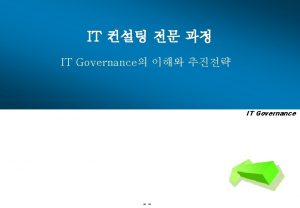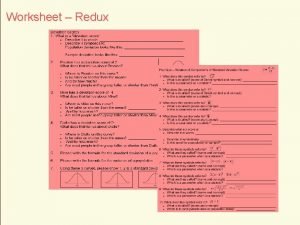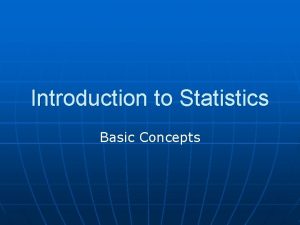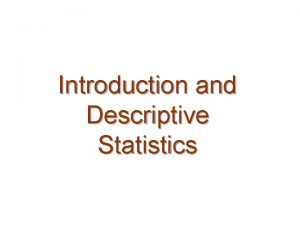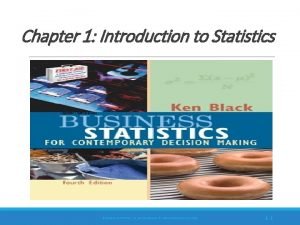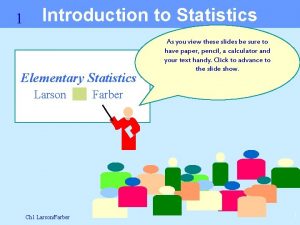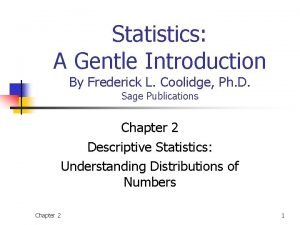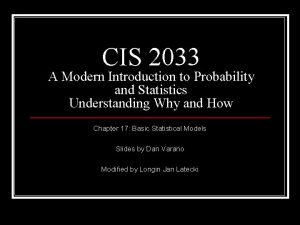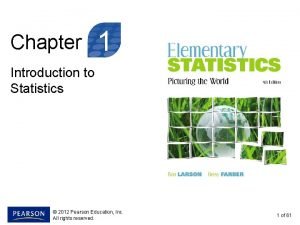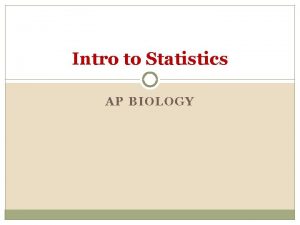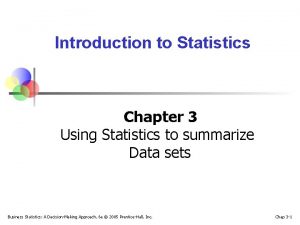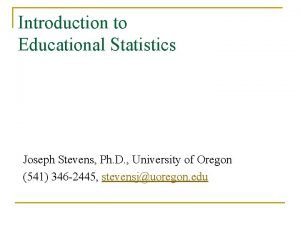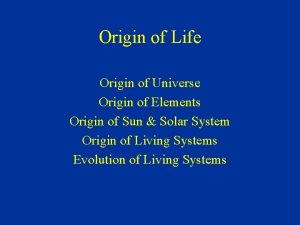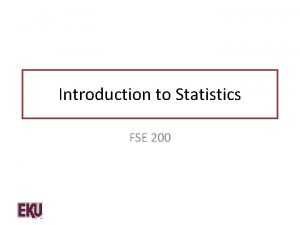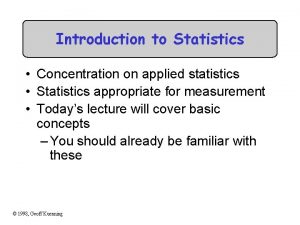Introduction to Statistics contents 1 Introduction 2 Origin























- Slides: 23

Introduction to Statistics

contents 1. Introduction. 2. Origin of statistics. 3. Meaning of statistics. 4. Definitions Of statistics. 5. Definition in of statistics in plural sense. 6. Features in terms of numerical data. 7. Features of statistics as science. 8. Scope. 9. Functions. 10. Uses and importance. 11. Limitations. 12. Distrust. 13. Remedies to remove Distrust. 14. Conclusion.

Introduction ØStatistics means numerical description to most people Ø The purpose of statistics is to manipulate, summarize and investigate data so that useful decision –making information results. ØStatistics is a set of decision making techniques which aids businessmen in drawing inferences from the available data.

ORIGIN OF STATISTICS Ø The term statistics has its origin in Latin word Status, Italian word Statista or German term statistik. All the three terms mean Political State. Ø In ancient periods , the beginning of statistics was made to meet the administrative needs of the state. Ø In modern times, statistics is not related to the administration of the state alone, but it has close relation with almost all those activities of our lives which can be expressed in quantitative terms.

MEANING OF STATISTICS ØThe term statistics has been generally used in two senses(1)Plural sense and (2)Singular sense. ØIn plural sense, the term statistics refers to numerical data or statistical data. ØIn singular sense, the term statistics refers to a science in which we deal with the techniques or methods for collecting, classifying, presenting, analyzing and interpreting the data.

DEFINITIONS OF STATISTICS These are broadly divided into two categories : 1. Definitions in plural sense. 2. Definitions in singular sense.


DEFINITIONS OF STATISTICS IN PLURAL SENSE Ø “Statistics are numerical statements of facts in any department of enquiry placed in relation to each other. ” -Bowley Ø “By Statistics we mean quantitative data affected to a market extent by multiplicity of causes. ” -Yule and Kendall

FEATURES OF STATISTICS IN PLURAL SENSE (1)Aggregate of Facts: It is only the aggregate of facts capable of offering some meaningful conclusion that constitute statistics. (2)Numerically Expressed : Statistics are expressed in terms of numbers. If the height of Kapil Dev is 6’ 2”, it would be taken as statistical information. (3)Affected by Multiplicity of causes: These are influenced by many factors simultaneously. (4)Reasonable Accuracy : A reasonable degree of accuracy must be kept in view while collecting statistical data. (5)Pre-determined Purpose: Statistics are collected with some pre-determined objective. (6)Enumerated or Estimated: Statistics may be collected by enumeration or these may be estimated.

Definitions of Statistics in SINGULAR SENSE Ø “Statistics may be defined as a collection, presentation, analysis and interpretation of numerical data. ” - Croxton and Cowdon Ø “Statistics is the science which deals with the collection, classification and tabulation of numerical facts as a basis for the explanation, description and comparison of phenomena. ” - Lovitt

FEATURES OF STATISTICS AS SCIENCE Ø Collection of data: It is decided as to how, when and where and what kind of data are to be collected. Ø Organization of data: the second step in statistical methods is to organize the collected data. Ø Presentation of data: To make the data intelligible, brief and attractive, it is presented in the form of tables, diagrams and graphs. Ø Analysis of data: To draw conclusions, it is necessary to analyze the data.

SCOPE OF STATISTICS SCOPE NATURE SUBJECT MATTER LIMITATIONS

FUNCTIONS OF STATISTICS Ø Expression of Facts in Numbers: One of the principal function of statistics is to express facts relating to different phenomena in numbers. Ø Simple Presentation: The data must be presented in a simple form, so that it becomes easy to understand. Ø It Compares facts: Another function of statistics is to compare data relating to facts. Ø It helps other sciences also: Many laws of economics, law of demand, law of supply have been verified with the help of statistics. Ø It helps in forecasting: It helps in forecasting changes in future with regard to a problem.

USES AND IMPORTANCE OF STATSTICS Ø Importance for Administrators or administration. Ø Importance for businessman or industrialist in the field of business, industry or agriculture. Ø Importance in economics. Ø Importance for politicians. Ø Importance for social reformer. Ø Importance in the field of science and research. Ø Importance for banking. Ø Importance in the field of education.

1. Importance for administrators administration: (a) Finance Minister makes use of data relating to revenue and expenditure while preparing budget. (b)Finance Minister takes decisions regarding imposition of new taxes, expenditure relating to import, production etc. 2. Importance for Businessman or Industrialist or Agriculturist: A successful businessman or agriculturist estimates demand for and supply of the commodity on the basis of relevant data. All this can be known with the help of statistics.

3. Importance in Economics: Economics depend upon statistics to measure economic aggregates such as gross national output, consumption, saving, investment, expenditure and changes in the value of money. 4. Importance for Politicians: Politicians play an important role in designing the economic, social and educational policies of the country. 5. Importance for social reformer: To a social reformer, statistics relating to such social evils as dowry, alcoholism, gambling, divorce etc are of great significance.

LIMITATIONS OF STATISTICS 1. 2. 3. 4. 5. 6. 7. 8. Study of numerical facts only. Study of aggregates only. Not the only method. Homogeneity of data. Results are true only on an average. Can be used only by experts. Misuse of Statistics is possible. Only means and not a solution.

Ø Study of numerical facts only: It does not study qualitative phenomena, like honesty, friendship, wisdom etc. Ø Study of aggregates only: Statistics studies only the aggregates of qualitative facts. It does not study any particular unit. Ø Not the only method: Many a time Statistical method does not suggest the best solution of each problem. Ø Homogeneity of data: To compare the data, it is essential that whatever statistics are collected, the same must be uniform in quality. Ø Misuse of statistics is possible: It is usually said, “Statistics are like clay of which you can make a god or devil, as you please”.

DISTRUST OF STATISTICS In spite of the usefulness of statistics and the confidence of the people in its efficacy, some people have misgivings about it and they distrust it. Those who distrust statistics make the following observations about it: 1. In the words of Disraeli, “There are three kinds of lies-lies, demand lies and statistics”. 2. Statistics is a rainbow of lies. 3. Statistics are tissues of falsehood. 4. Statistics can prove anything. 5. Statistics cannot prove anything.

DISTRUST OF STATISTICS The main cause of Distrust is that most of the people believe statistics readily, but some selfish people make misuse of the statistical data. The main causes of the mistrust of statistics are as under: 1. Different kinds of statistics are obtained in respect of a given problem. 2. Statistics can be altered to prove predetermined conclusions. 3. In it results are mostly wrong.

REMEDIES TO REMOVE DISTRUST 1. Consideration of statistical limitations: While making use of statistics, limitations of statistics must be taken care of, for instance, statistics should be homogeneous. 2. No bias: Researcher should be impartial. He should make use only of proper data and draw conclusions without any bias or prejudice. 3. Application by Experts: Statistics should be used only by the experts. If they use it carefully and scientifically, the possibilities of errors will be little.

CONCLUSION Statistics is a set of decision-making techniques which aids businessmen in drawing inferences from the available data. Statistics is taken from the Latin word Status. Statistics has its features but there also limitations of it. Statistics also perform the functions like expression of facts in numbers, simple presentation etc. It has also have importance in fields like for administrators, businessman, in economics etc. In spite of the usefulness of statistics and the confidence of the people in its efficacy , some people have misgivings about it and they distrust it. A competent doctor can cure the malady by making good use of the medicine but the same medicine in the hands of an incompetent doctor becomes poison. But in spite of it we take measures to remove distrust like no bias, applications by experts.

 Introduction to statistics what is statistics
Introduction to statistics what is statistics Contents introduction
Contents introduction Introduction to statistics worksheet
Introduction to statistics worksheet Introduction to statistics and some basic concepts
Introduction to statistics and some basic concepts Introduction to descriptive statistics
Introduction to descriptive statistics Chapter 1 introduction to statistics
Chapter 1 introduction to statistics Introduction to bayesian statistics
Introduction to bayesian statistics Introduction to elementary statistics
Introduction to elementary statistics Statistics a gentle introduction
Statistics a gentle introduction A modern introduction to probability and statistics
A modern introduction to probability and statistics Chapter 1 introduction to statistics
Chapter 1 introduction to statistics Introduction to statistics in ap biology
Introduction to statistics in ap biology Percentile example
Percentile example Introduction to educational statistics
Introduction to educational statistics Career portfolio definition
Career portfolio definition Deep perineal pouch contents
Deep perineal pouch contents Trali symptoms
Trali symptoms Fresh frozen plasma contents
Fresh frozen plasma contents Mediastnum
Mediastnum Adductor hiatus
Adductor hiatus Boundaries of mediastinum
Boundaries of mediastinum The immortal life of henrietta lacks table of contents
The immortal life of henrietta lacks table of contents Medial lemniscus
Medial lemniscus Posterior scapular region
Posterior scapular region

